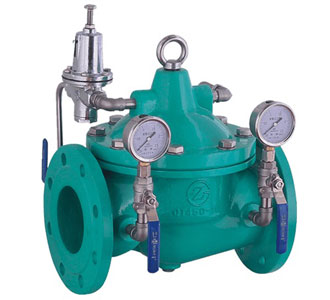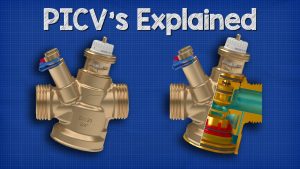Valves have been widely used in various industries, suitable for pipes and equipment such as water and gas. Butterfly valve manufacturers, let us briefly explain the working principles of many different types of pressure reducing valves.
Pressure Reducing Valve Working Principle
The pressure on the outlet side increases, the membrane moves upward, the valve opening decreases, the flow increases, the pressure drop increases, and the pressure behind the valve decreases; the outlet pressure decreases, the membrane moves downward, the valve opening increases, the flow decreases, and the pressure decreases. The droplets decrease and the pressure behind the valve increases. The outlet pressure behind the valve always maintains the constant pressure set by the setting adjustment screw.

Direct Acting Bellows Type Pressure Regulating Valve Working Principle
The pressure on the outlet side increases, the bellows move upward, the valve opening decreases, the flow increases, the pressure drop increases, and the pressure behind the valve decreases; the pressure on the outlet side decreases, the bellows move downward, the valve opening increases, the flow decreases small. The pressure drop decreases and the pressure behind the valve increases. The outlet pressure behind the valve always maintains the constant pressure set by the setting adjustment screw.
Pilot Piston Pressure Reducing Valve Working Principle
Tighten the adjusting screw, open the pilot valve cover, and the medium enters the piston from the inlet side. The area of the plug is larger than the area of the main valve cover. Push the piston down to open the main valve. After the valve is balanced, the pressure of the spring adjusts the opening of the pilot valve, thereby changing the pressure above the piston and controlling the opening of the main valve flap. Keep the pressure behind the valve constant.
Pilot Membrane Pressure Reducing Valve Working Principle
Operating Principle No. 3. The piston is slowed by the membrane, and the pressure in the upper chamber of the membrane is controlled by the bypass regulating valve.
When the adjusting spring is in the free state, both the main valve and the pilot valve are closed. When the handwheel rotates clockwise, the diaphragm of the pilot valve is downward, the pilot valve opens, the medium passes through the pilot valve to the top of the diaphragm, the main valve is pushed, the main valve opens, the medium flows to the outlet, and the cylinder enters the diaphragm under the pilot valve. The outlet pressure rises to maintain balance with the adjusted spring force. If the outlet pressure increases, the pilot diaphragm moves upward and the pilot opening decreases. At the same time, the flow rate of the medium entering the main diaphragm is reduced, the pressure is reduced, the opening of the main valve is reduced, the outlet pressure is reduced, and a new balance is reached, and vice versa.
Combined Pressure Reducing Valve Working Principle
Pressure reducing valve consists of the main valve, pilot valve, and globe valve. When the adjustment spring is in a free state, the main valve and the pilot valve are closed. Twist the adjusting screw, the medium pushes the pilot valve, enters chamber 1 and the pressure balance of the adjusting spring, and enters the rubber film chamber 2 of the main valve. The rubber diaphragm is upward, the main valve is opened, and the medium flows to the outlet. The shut-off valve is opened to maintain the pressure at which chamber 2 moves. The outlet medium is sent back to upper chamber 3 of the rubber film and chamber 4 below the pilot valve. When the outlet pressure increases, the diaphragm of the pilot valve moves upward, the opening degree of the pilot valve decreases, and the medium pressure of chamber 1 decreases. The pressure in chamber 2 drops, the rubber membrane of the main valve moves downward, the opening of the main valve decreases, the outlet pressure drops, and a new balance is reached, and the perception is the same.
Lever Type Pressure Reducing Valve Working Principle
This is a pressure reducing valve that balances the pressure by the weight of the lever. Operating principle: When the lever is in a free state, the valve disc and the valve seat of the double valve seat are closed. Under the effect of the inlet pressure, the valve flap is pushed upward, and pressure is formed at the outlet end. Through the balance weight on the lever, adjust the weight to the required outlet pressure. When the outlet pressure exceeds a given pressure, due to the force of the middle pressure acting on the upper valve seat, the force on the valve seat is very large, forming a certain pressure difference, that is, the flap moves downward, reducing the throttle area, the outlet The pressure also drops, reaching a new balance (and vice versa).
pilot bellows-type Pressure Reducing Valve Working Principle
Turn the adjusting screw to open the valve disc of the pilot valve, and the medium enters the piston from the inlet side. Since the area of the piston is larger than the area of the main disc, the piston is pushed down to open the main valve and the pressure of the spring balance adjustment spring changes. The opening of the valve changes the pressure above the piston and controls the opening of the main flap to keep the pressure behind the valve constant.
Related Tags :
Ten articles before and after
How did the pneumatic ball valve evolve? – Zeco Valve | API 6D ball valve manufacturer
Where is the importance of electric butterfly valves? – Zeco Valve | API 6D ball valve manufacturer
What is the classification method of pneumatic valves? – Zeco Valve | API 6D ball valve manufacturer
What is the main purpose of using the gate valve? – Zeco Valve | API 6D ball valve manufacturer












